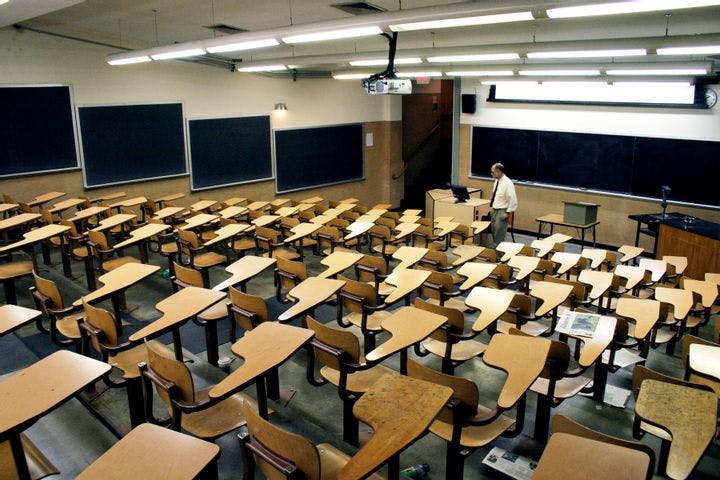Why do so few conservatives work in higher education?
– Eric Nong
To some degree, it’s self-selection, but there are other factors at play.
It’s a common trope that American university professors tend to be more politically liberal than conservative. This divide, according to Stephen Hayward writing for The New Criterion, is most pronounced in the humanities and social sciences, where a professor’s political beliefs can greatly impact the courses they teach. He does not rely on strictly on data (though the dominance of left-leaning professors in the academic world is supported by a 2012 study from the UCLA Higher Education Research Institute), but largely draws from passages written by political philosophers, and observational analysis.
Hayward writes that ideological “monopolies” in any professional institution can result in personal ideological bubbles — left, right, or center. A lack of conservative professors or courses and lesson plans dedicated to right-leaning materials, says Hayward, is unconducive to a complete and critical discourse within the liberal arts; by extension, he is skeptical that liberal-leaning professors can present conservative views accurately. Borrowing from John Stuart Mill, Hayward opines that the most effective professors must actually believe the viewpoints they are teaching, “who defend them in earnest, and do their utmost for them,” and, “know them in their most plausible and persuasive form.” Otherwise, higher education becomes nothing more than an echo chamber of academic dogma.
Many liberal professors do present conservative arguments in the classroom, but this is beside Hayward’s point; he is primarily concerned that these liberal professors are unable to present conservative positions with the same fervor, expertise, or respect as would a staunchly conservative professor.
What about professors who refuse to entirely subscribe to rightist or leftist beliefs and present both their viewpoints dispassionately, allowing students to formulate their own opinions? Because of a lack of quantitative evidence surrounding different teaching methods used by professors with different ideological positions, Hayward is forced to base his hypothesis on (unsavory, but, to him, necessary) generalizations about conservative students and professors.
So why is there a dearth of conservative professors in American universities? Hayward notes that the reasons why students enter graduate school are not due to ideology, but whether or not they have a base of moral support encouraging them to pursue advanced degrees. There are few such professors or mentors guiding conservative students towards graduate education, leading to a shallow pool of conservative professorial candidates to hire. Thus, the relationship between the absence of mentors and the prevalence of liberal-leaning professors in higher education becomes self-reinforcing.
Yet, this does not answer why there are so many liberal professors in the social sciences and humanities in the first place. To answer this question, Hayward begins to rely on anecdotal evidence as he draws from his experiences in interacting with conservative university students; he believes they are “alienated from the research university mode of inquiry.” Most conservative students and professors dedicating themselves to the liberal arts are usually engaged in political philosophy (not “philosophy proper”) or economics — two subjects with established non-academic uses. Political philosophy and economics are more “directly oriented toward the concrete over the abstract.” Presumably, both fields of the liberal arts have more practical application regarding professional careers.
When coupled with the ballooning costs of higher education — since 1983, tuition at four-year public universities has risen 257% as an average family income has only increased 16% — the prospect of a degree in the humanities or social sciences looks less appealing, given the prospect of a low-paying career path and insurmountable student loan debt. With Hayward noting that this “decline in humanities and social science enrollment began long before the current economic downturn,” a conservative student interested in the liberal arts might deduce that studying political philosophy or economics suits his or her ideological habits (favoring tangible examples over theoretical concepts). This creates a vicious cycle, wherein conservative students are discouraged from participating in graduate programs within the humanities and social sciences due to the cost of higher education and lack of like-minded professors or mentors.
A well-balanced education should enable an individual to fully express and comprehend one’s political beliefs as masterfully as its counter-arguments. Whether or not that requires professors of starkly contrasting ideological spectrums, it will almost certainly inspire pushback from students and faculty alike. For Hayward, a healthy exchange of dissimilar ideas — complemented by an ideologically diverse academic environment — can energize both conservatism and liberalism, forcing each to understand the other and rapidly evolve their arguments to remain relevant.
The Source: “Conservatives & Higher Ed” by Stephen F. Hayward, New Criterion, June 2014.
Photo courtesy of Flickr/Shaylor
